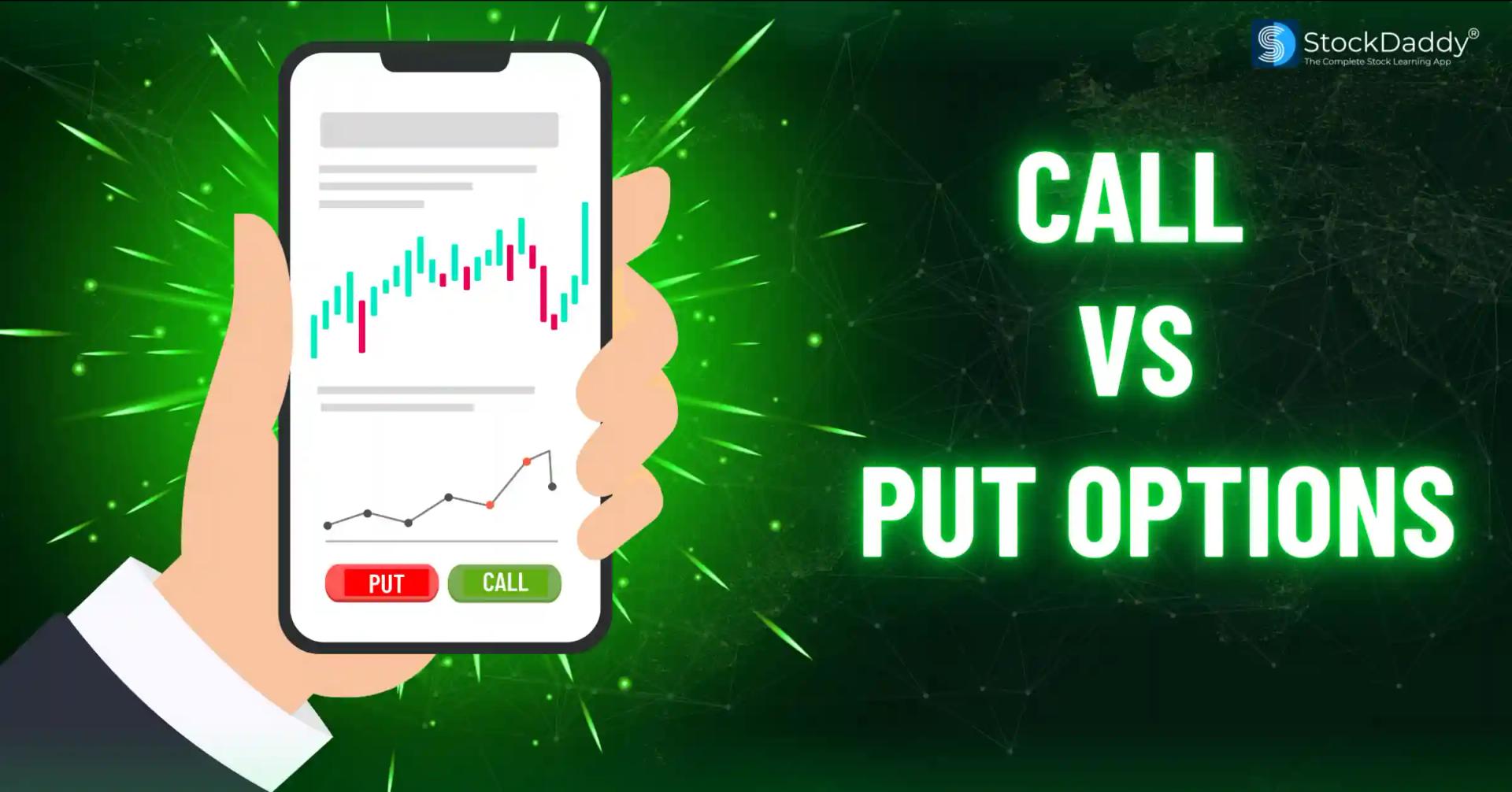Blog >
Difference Between Call and Put Option
Difference Between Call and Put Option

Options are a derivative contract of a kind that are traded on a stock exchange like NSE or BSE. They have their value as an underlying asset. Options can be of two types- stock options and index options, and they are further divided into types- call option and put option.
An options contract gives the owner the right, but not the obligation, to purchase or sell the asset underlying the option at a predetermined price during a set period. The buyer of an option pays a premium for having this right, while the seller gets a premium but is obligated to complete the deal if the buyer exercises their option. These contracts are bought and sold by the investors for different purposes such as hedging, speculation, and arbitrage.
What is a Call Option?
A call option is a contract with a specific expiration date where the holder has the option to purchase the underlying asset at a certain strike price within a certain time frame. Its value increases when the price of the underlying asset increases and decreases when the price of the asset decreases.
For example- There is a company called X Ltd. trading at Rs.100/share and you expect that the price of the company will reach Rs.120/share in a month’s time. In this case, you can buy a call option with:
Strike Price- Rs.120
Premium- Rs.10
Expiry Date- 1 month
If the price of the stock reaches Rs.140 in a month's time, then you can exercise your option by buying the stock at Rs.120. Then you can immediately sell it to book a profit of Rs.10/share (140-120-10).
However, if the share price does stays at Rs.110/share by the time the option expires, you can decide not to exercise your right to buy and, in this case, you will only lose your premium amount i.e. Rs.10/share.
What is a Put Option?
A put option works by enabling the owner to sell the underlying asset at a predetermined price, or strike price, within a stipulated time. This is a gain for the buyer: they financially benefit when the market price of the asset falls below the strike price since they can then exercise the right to sell at the higher strike price.
Suppose the stock price at present is ₹100 and you buy a put option with the below conditions:
Strike Price: ₹100 (the price at which you can sell)
Premium: ₹5 (price that you incur to buy the option)
Expiry: 1 month (period of time within which you can exercise your option)
Your Right: This put option gives you the right, but not the obligation, to sell one unit of this share at ₹100 at any time until the expiry of the option.
If the market price of the share drops to ₹80, you can exercise your put option and sell the same share at the strike price of ₹100 and earn gross profit of ₹100 (market price) - ₹80 (strike price) = ₹20 per share and a net profit of ₹20 (gross profit) - ₹5 (premium) = ₹15 per share.
In case the share price remains at or above ₹100 until expiry, you wouldn't exercise your option since you may be able to sell at similar or better price in the open market.
Here, your worst-case best loss is confined to the premium you had paid initially, i.e., ₹5 per share.
Put options are extensively used as a hedge strategy, used as insurance against potential declines in the stock price in the future, especially by shareholders who are already holding the stock.
With the best options trading course learn to understand various technical analysis indicators, chart patterns, and candlesticks.
Key differences between Call Option and Put Option
Here are some of the key differences between a call option and a put option which you should know of;
| Feature | Call Option | Put Option |
| Definition | A call option is a financial contract which gives the buyer the right to buy the underlying asset at a predetermined price. | A put option is a financial contract which gives the person holding the contract the right to sell the underlying asset at a predetermined price. |
| Price Outlook | Having a call option indicates that the buyer has a positive outlook towards the market and expects the price of the stock to rise in the future. | Purchasing a put option is an indicates bearish outlook towards the market and the buyer expects the price of the stock to fall. |
| Purpose | The sole purpose of the purchase is to book profit from the rise in stock prices. | On the other hand, with put options the buyer aims to profit from the fall in future stock prices. |
| Strike Price | In call option, strike price is the price at which buyer can buy the stock in the future. | In call options, strike price is the price at which the seller can sell the stock in the future. |
| Profit scope | In call option, buyer can earn profits if the strike price is below the actual price of the stock in the future. | In put option, the buyer is profitable if the strike price is above the actual price of the stock in future. |
Conclusion
In summary, call and put options contracts are useful tools for investors to hedge against loss, speculate on price movements, and arbitrage. From an underlying asset, these versatile financial instruments are used both for risk management and exploiting market movements.
Call options grant the holder the ability to purchase, while put options grant the right to sell, both of which entail varying advantages and strategic uses. Through awareness of the inherent differences between these options, moneyness, and the pressures that drive their price, investors can make more sound decisions for optimizing their portfolios

- Recent Blogs
- What is gold Bees ETF and How to invest in it?
- Difference Between Call and Put Option
- Types of Charts in Stock Market
- what is CPSE etf and How is it a good investment Opportunity
- What is Margin Trading Facility
- why Tata Motors Share is Falling?
- Disadvantages of SIP Investment You Should Know
- Can Stock Market make you Rich?
- Difference Between Sensex and Nifty
- Difference Between Fundamental Analysis and Technical Analysis